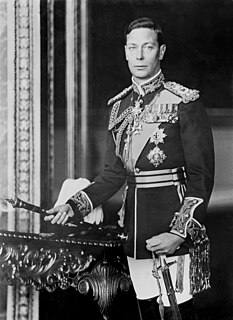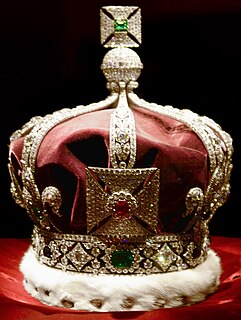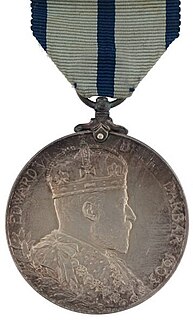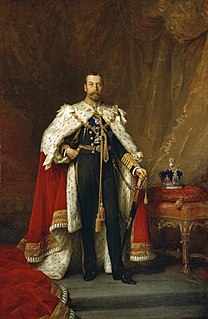Related Research Articles

Mary of Teck was Queen consort of the United Kingdom and the British Dominions from the accession of her husband, King George V, in 1910 until his death in 1936. She was concurrently Empress of India.

Emperor or empress of India, shortened to king-emperor or queen-empress, was a title used by British monarchs from 1 May 1876 to 22 June 1948. The image of the emperor or empress was used to signify British authority—his or her profile, for instance, appearing on currency, in government buildings, railway stations, courts, on statues etc. "God Save the King" was the former national anthem of British India. Oaths of allegiance were made to the emperor or empress and the lawful successors by the governors-general, princes, governors, commissioners in India in events such as imperial durbars.

The Cullinan Diamond was the largest gem-quality rough diamond ever found, weighing 3,106.75 carats (621.35 g), discovered at the Premier No.2 mine in Cullinan, South Africa, on 26 January 1905. It was named after Thomas Cullinan, the mine's chairman. In April 1905, it was put on sale in London, but despite considerable interest, it was still unsold after two years. In 1907, the Transvaal Colony government bought the Cullinan and then presented it to Edward VII, King of the United Kingdom, who had it cut by Joseph Asscher & Co. in Amsterdam.

Princess Marie Louise of Schleswig-Holstein was a granddaughter of Queen Victoria.

The Imperial Crown of India is the crown used by King George V in his capacity as Emperor of India at the Delhi Durbar of 1911.

The Crown Jewels of the United Kingdom, originally the Crown Jewels of England, are a collection of royal ceremonial objects kept in the Tower of London, which include the regalia and vestments worn at their coronations by British kings and queens.

St Edward's Crown is the centrepiece of the Crown Jewels of the United Kingdom. Named after Saint Edward the Confessor, it has been traditionally used to crown English and British monarchs at their coronations since the 13th century.

The coronation of the British monarch is a ceremony in which the monarch of the United Kingdom is formally invested with regalia and crowned at Westminster Abbey. It corresponds to the coronations that formerly took place in other European monarchies, all of which have abandoned coronations in favour of inauguration or enthronement ceremonies.

The Delhi Durbar was an Indian imperial-style mass assembly organized by the British at Coronation Park, Delhi, India, to mark the succession of an Emperor or Empress of India. Also known as the Imperial Durbar, it was held three times, in 1877, 1903, and 1911, at the height of the British Empire. The 1911 Durbar was the only one that a sovereign, George V, attended. The term was derived from the common Mughal term durbar.

With Our King and Queen Through India (1912) is a British documentary. The film is silent and made in the Kinemacolor additive color process.

Coronation Park is a park located on Burari Road near Nirankari Sarovar in Delhi, India. The park is sometimes referred to as the Coronation Memorial; it was the venue of the Delhi Durbar of 1877 when Queen Victoria was proclaimed the Empress of India. Later it was used to celebrate the accession of King Edward VII in 1903, and, finally, it was here that the Durbar commemorating the coronation of King George V as Emperor of India took place on 12 December 1911, subsequent to his coronation at Westminster Abbey in June 1911. This last celebration had all the princely states in attendance. The decision to hold the Coronation Durbars in Delhi at the vast open ground at Coronation Park was a move to emphasise the historical significance of Delhi as the former capital of the Mughal Empire.

The King George V Coronation Medal was a commemorative medal instituted in 1911 to celebrate the coronation of King George V, that took place on 22 June 1911.

Lieutenant-General Pratap Singh, was a career British Indian Army officer, Maharaja of the princely state of Idar (Gujarat) and heir to Ahmednagar later renamed as Himmatnagar from 1902 to 1911, when he abdicated in favour of his adopted son.

The monarch of the Commonwealth realms, Queen Elizabeth II, owns a historic collection of jewels – some as monarch and others as a private individual. They are separate from the Gems and Jewels and the coronation and state regalia that make up the Crown Jewels.

Admiral Sir Henry Frederick Stephenson was a Royal Navy officer, courtier, and Arctic explorer.

The coronation of George VI and his wife Elizabeth as king and queen of the United Kingdom and the Dominions of the British Commonwealth took place at Westminster Abbey, London, on 12 May 1937. George VI ascended the throne upon the abdication of his brother, Edward VIII, on 11 December 1936, three days before his 41st birthday. Edward's coronation had been planned for 12 May 1937 and it was decided to continue with his brother and sister-in-law's coronation on the same date.

Delhi Durbar Medals were instituted by the United Kingdom to commemorate the Delhi Durbar where the new Emperor of India was proclaimed, in 1903 for Edward VII, and in 1911 for George V. On both occasions the medals were one and a half inches in diameter and were awarded in both gold and silver. They were worn in date order alongside Coronation and Jubilee medals on the left chest, suspended from a ribbon one and a quarter inches wide. These Royal commemorative medals were worn before campaign medals until November 1918, after which the order of wear was changed, with them now worn after campaign medals and before long service awards.

The coronation of George V and his wife Mary as king and queen of the United Kingdom and the British Empire took place at Westminster Abbey, London, on 22 June 1911. This was second of four such events held during the 20th century and the last to be attended by royal representatives of the great continental European empires.

Delhi Durbar Medals were instituted by the United Kingdom to commemorate the Delhi Durbar where the new Emperor of India was proclaimed, in 1903 for Edward VII, and in 1911 for George V. On both occasions the medals were one and a half inches in diameter and were awarded in both gold and silver. They were worn in date order alongside Coronation and Jubilee medals on the left chest, suspended from a ribbon one and a quarter inches wide. These Royal commemorative medals were worn before campaign medals until November 1918, after which the order of wear was changed, with them now worn after campaign medals and before long service awards.
References
- Russell Hulme, David (2001). "German, Edward". In Sadie, Stanley; Tyrrell, John (eds.). The New Grove Dictionary of Music and Musicians (2nd ed.). London: Macmillan. pp. 703–705.
- Rees, Brian (1986). A Musical Peacemaker: The Life and Work of Sir Edward German. Abbotsbrook: Kensal Press.
- Scott, William Herbert (1932). Edward German: An Intimate Biography. London: Cecil Palmer.